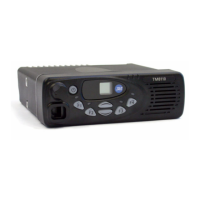TM8100/TM8200 Service Manual Description 25
© Tait Electronics Limited June 2006
2.1.2 Control Head with Graphical Display
Overview The control head can be divided into the following main areas:
■ front panel with control elements, indicators, LCD, speaker, and
concealed microphone (optional)
■ space-frame and seals
■ control-head board with SMT components, shielding cans, connectors,
and volume potentiometer
■ control-head loom with female-female adapter
■ adapter flange.
The circled numbers in this section refer to the items in Figure 2.4 on
page 27.
Front Panel
Assembly
The front panel assembly 1^ consists of an injection-moulded plastic part
with an integrated transparent light pipe element for the radio
STATUS LEDs,
a transparent lens which cannot be replaced, a cloth membrane which is
fixed to the speaker grille, and a foam seal inside a rectangular LCD recess
behind the lens. A label
1* with the radio model number is attached to the
front panel assembly with self-adhesive coating and can be replaced for
rebranding purposes.
Three clips on the rear side of the front panel assembly snap onto the space-
frame to hold the keypads
1# and 1#, the LCD assembly 1@ and the speaker
1! in place. The rear side of the front panel assembly also has four screw
bosses to fasten the control-head board
F.
Knob for
Volume-Control
Potentiometer
The knob for the volume-control potentiometer 1& is fitted to the shaft of
the volume-control potentiometer, which is soldered to the control-head
board
F.
Keypads The main keypad 1# (for the function, selection, and scroll keys) and the
power keypad
1$ protrude through apertures in the front panel assembly 1^.
The rear sides of these keypads connect directly to the relevant contacts on
the control-head board
F.
LCD Assembly The graphical-display LCD assembly 1@ sits on a foam seal inside a
rectangular recess of the front panel assembly
1^. Another foam seal is
attached to the rear of the LCD with self-adhesive coating. The LCD
assembly has a loom, which runs through a slot in the space-frame
J and
connects to a connector on the rear side of the control-head board
F.

